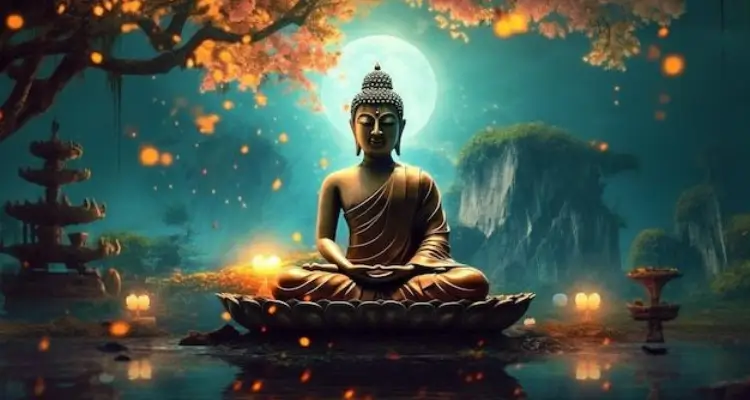The concept of Nirvana is central to many religious traditions, especially in Hinduism and Buddhism, although its meaning can vary from one religion to another. For many, Nirvana is seen as a state of perfection or liberation. However, in each religious context, it can represent different things. In Hinduism, for example, Nirvana is associated with union with the divine and liberation from the cycle of reincarnation. In Buddhism, Nirvana is the cessation of suffering and the end of the rebirth cycle, a state of deep peace and inner realization.
In Buddhism, Nirvana is often misunderstood as a type of paradise or eternal heaven. However, this understanding is not accurate. Unlike what many think, Nirvana is not a place but an internal experience that occurs when the desires and passions that bind us to suffering are extinguished. The word “Nirvana,” originating from Sanskrit, literally means “extinguished fire,” referring to the extinguishing of the flames of desire, aversion, and ignorance that cause human suffering.
It is important to emphasize that, for Buddhism, the quest for Nirvana involves a profound transformation of the mind and perception of the world. It is not a distant goal or something impossible to attain, but a shift in perspective that allows the individual to see beyond Samsara—the continuous cycle of birth, death, and rebirth. Nirvana, thus, is not something to be found outside of us but something that already exists within, waiting to be recognized.
This article will explore the concept of Nirvana in Buddhism, helping to understand how it relates to other religious traditions and what it truly represents in Buddhist practice. From this understanding, it will be possible to reflect on how Nirvana can be lived in daily life and how it offers a path to liberation from suffering.
Origin and Meaning of the Word Nirvana
The word “Nirvana” has its roots in Sanskrit and is composed of two parts: “nir” and “vana.” The particle “nir” is a negative form, conveying the idea of “not” or “absence.” The word “vana” means “fire,” and together, these two elements form the term Nirvana, which can be translated as “extinguished fire” or “the extinction of fire.” In the Buddhist context, this “fire” refers to the fire of passions, feelings, and human desires.
The “fire of passions” is a metaphor for the desires and the craving for what we do not possess but believe we need to be happy. These desires are not limited to material things, such as wealth or power, but also extend to emotions and feelings like anger, envy, and even attachment. In Buddhism, these desires are seen as sources of suffering because when we are in a constant search for what we do not have or fear losing what we already possess, we become trapped in a cycle of continuous dissatisfaction, which is the essence of human suffering.
Therefore, Nirvana represents the extinction of this “fire,” a state in which desires and passions no longer control us. Achieving Nirvana means ending the cycle of insatiable desires that fuel suffering and reaching a state of inner peace. This does not mean that Nirvana is a state of passivity or indifference, but rather a profound transformation of the mind and perception of the world, where one is freed from the attachments that cause dissatisfaction and suffering.
In this sense, the understanding of Nirvana is closely linked to the idea of internal change. It is not about an external achievement, like the possession of something or the realization of a goal, but rather a state of inner balance where passions and desires are extinguished, giving way to peace and harmony.
Nirvana in Buddhism: Internal Change, Not a Place
In Buddhism, Nirvana is not considered a paradise or heaven, as in some other religions. Instead, it is a state of internal transformation of the mind, reflecting a profound change in the way we perceive the world and relate to our desires and passions. The idea of Nirvana is rooted in the understanding that human suffering is caused by our attachments and selfish desires. Achieving Nirvana, therefore, does not mean reaching a physical place of eternal happiness, but extinguishing the “fire” of passions that fuel the cycle of dissatisfaction and suffering.
To attain Nirvana, it is necessary to understand and master desire. In Buddhism, desires are seen in two ways: there are desires that do not cause suffering, such as the desire to perform good actions, help others, or seek enlightenment for the benefit of all; and there are desires that imprison us in suffering, such as the desire for possession, control, or craving for material things. Suffering arises when we become enslaved by these selfish desires, which keep us trapped in the cycle of craving and dissatisfaction.
Achieving Nirvana involves learning to distinguish between these two types of desires and working to extinguish those that cause suffering while cultivating those that promote collective well-being and wisdom. This process of internal transformation involves changing the mind and perception, allowing a person to live in a more balanced, serene way, connected to the world around them. True freedom in Buddhism, therefore, is freedom from selfish desire, which keeps us bound to samsara, the cycle of birth, death, and suffering.
Thus, Nirvana is not a state of “escaping” life, but a process of living fully in the present moment, with a peaceful mind and free from the pressures of desires that cause suffering. It is an internal liberation, a deep peace that comes from within, not from an external place or condition.
Understanding Samsara: The World of Dissatisfaction
In Buddhism, Samsara is described as the endless cycle of seeking satisfaction that is never truly achieved. It is the world of dissatisfaction, where we are constantly searching for something that we believe will bring us happiness, but no matter how much we obtain, it never fully fills us. The essence of Samsara lies in desire and the craving for something we don’t yet have or the fear of losing what we already possess. These emotions create an endless cycle of dissatisfaction, where we can never find lasting peace.
Dissatisfaction, therefore, arises from our relationship with desire. We desire material possessions, status, or even emotions and situations we think will be the key to happiness. When we get what we want, we soon feel the need for something more, something bigger, newer, or more perfect. If we lose something we already have, we experience fear and anxiety. This cycle of desires and fears keeps us in a constant state of unease and discomfort, preventing us from experiencing true happiness.
Moreover, the constant comparison between our material possessions and those of others only heightens the feeling of dissatisfaction. We live in a society that teaches us to measure our happiness based on what we have compared to others. This comparison takes us further from true happiness, as we fail to realize that it is not found in external things, but in an internal state of peace and contentment.
Samsara is, therefore, a never-ending cycle where we are always seeking happiness in external sources but never achieving it in a lasting way. True happiness in Buddhism lies in freeing ourselves from this cycle, extinguishing the fire of passions, and finding inner peace, Nirvana.
The Relationship Between Nirvana and Samsara
In Buddhism, one of the most intriguing ideas is that Nirvana and Samsara coexist in the same “place,” meaning they are not separate worlds. The difference between the two lies in our perception, in the way we see and interpret the reality around us. Samsara, the cycle of dissatisfaction and suffering, is the experience we have when we are dominated by our desires and fears, seeking happiness in external things, yet never achieving it in a lasting way. Nirvana, on the other hand, is inner peace, the state of liberation from selfish desires, and this internal change allows us to find the happiness we have been seeking.
The key to understanding this relationship is realizing that what prevents us from seeing Nirvana is the way we look at the world. If we continue to look through the “eyes” of passion and desire, we will only see suffering and dissatisfaction—the traps of Samsara. However, if we change our perception and adopt a deeper, more serene view, like the view of Buddha, we will be able to perceive Nirvana, which is already present in our life, in our mind, and within us. Nirvana is not something we must search for in some distant place or future; it is accessible to us here and now, depending on how we choose to see the world.
This change in perspective is crucial. By changing our gaze, we can transcend the cycle of Samsara and attain the state of Nirvana. It is not about finding something new, but about transforming the way we relate to what is already before us. Therefore, Nirvana and Samsara are not separate entities, but two different ways of perceiving the same reality. True freedom comes when we are able to see the world clearly, free from the distortions caused by desires and fears.
Conclusion
Nirvana, in the context of Buddhism, is much more than an abstract concept or an ultimate destination. It represents an internal transformation, a state of liberation from the selfish passions and desires that imprison us in the cycle of suffering and dissatisfaction known as Samsara. Rather than being a place or a reward in the afterlife, Nirvana is an experience that can be lived in the present, accessible to all who seek inner change and serenity. It arises when we manage to extinguish the “fire” of our anxieties, fears, and desires, changing the way we perceive the world around us.
To attain Nirvana, it is not necessary to search for something outside of ourselves, but rather to change the way we see reality. The first step is understanding that happiness is not found in external things, nor in material possessions, but within our minds and in how we choose to respond to the circumstances of life. When we manage to view the world with the serene and enlightened perspective of Buddhist teachings, Nirvana becomes not only a possibility but a present reality in our daily lives.
Thus, the invitation is to reflect on your own perception of the world. How are your beliefs, desires, and fears influencing your life experience? The internal change that Buddhism proposes may be the path to a quieter, fuller, and more meaningful life. By adopting a new perspective, we can find Nirvana in our everyday life, in the stillness of the mind and the freedom of not being prisoners to our desires.

































